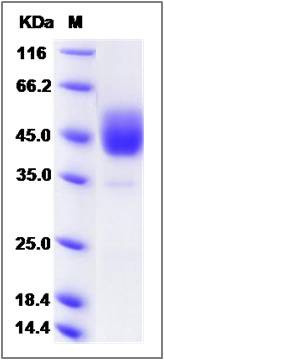Rhesus ALK-7 / ALK7 / ACVR1C Protein (Fc Tag)
ACVR1C
- 100ug (NPP1058) Please inquiry
| Catalog Number | P90067-C02H |
|---|---|
| Organism Species | Rhesus |
| Host | Human Cells |
| Synonyms | ACVR1C |
| Molecular Weight | The recombinant rhesus comprises 330 amino acids and has a calculated molecular mass of 36.6 KDa. |
| predicted N | Gly 25 |
| SDS-PAGE |  |
| Purity | > 95 % as determined by SDS-PAGE |
| Protein Construction | A DNA sequence encoding the rhesus ACVR1C (NP_001253619.1) (Gly25-Glu113) was expressed with the Fc region of human IgG1 at the C-terminus. |
| Bio-activity | |
| Research Area | Cardiovascular |Angiogenesis |Cytokine & Receptor |Transforming Growth Factor Beta (TGF-beta) Superfamily |Transforming Growth Factor Beta (TGF-beta) Family |TGF-beta Family Receptor | |
| Formulation | Lyophilized from sterile PBS, pH 7.4 1. Normally 5 % - 8 % trehalose, mannitol and 0.01% Tween80 are added as protectants before lyophilization. Specific concentrations are included in the hardcopy of COA. |
| Background | ALK-7, also known as ALK7 and ACVR1C, belongs to the ALK family. It is a type I receptor for the TGFB family of signaling molecules. TGF-β is the prototype of a protein superfamily which, in humans, contains at least 35 members, including activins, inhibins, bone morphogenetic proteins, growth/differentiation factors, and Müllerian inhibiting substance. ALK-7 is a serine-threonine kinase that can cause the activation of one of the SMAD signal transducers, SMAD2. ALK-7 has a ligand known as Nodal. Nodal stimulates the secretion of TIMP-1 and inhibits matrix metalloproteinases MMP-2 and MMP-9 activity. The overexpression of Nodal or constitutively active ALK-7 decreases cell migration and invasion, whereas knock-down of Nodal and ALK-7 has the opposite effects. |
| Reference |
